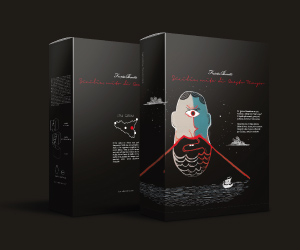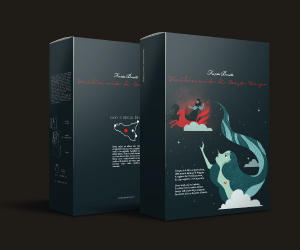
Among the myths of the past
A land, its stories
Five Packs inspired by the extraordinary myths of Sicily






POLYPHEMUS
The figure of Polyphemus is traditionally connected to the version of the myth that Homer gives us in the Odyssey. Legend has it that Ulysses, having landed in the Land of the Cyclops and driven by his innate spirit of adventure, reached the cave of Polyphemus, son of the god Poseidon, ending up trapped with all his navigation companions and with the one-eyed giant ready to eat them one by one.
The rest is known history. To get out of the cave, Ulysses decided to get the terrible giant drunk so that he could blind him and leave the cave undisturbed. Noticing the escape of his guests, Polyphemus began throwing some boulders from a promontory in order to sink the boat of the king of Ithaca, who, laughing, shouted the famous phrase to the Cyclops: “If anyone asks you who blinded you, answer that it was Nobody “.
“Da Toosa e Poseidone nacque.
Polifemo, ciclope che “mai tacque”
D’Apollo gli armenti governava
in Sicilia, dove Aci Trezza stava
Narra Omero: d’Ulisse beffato.
Ebbro di vino, da un palo accecato.
Narra Ovidio: d’amor sofferente
per Galatea, nereide suadente.”
POLYPHEMUS
“If someone asks you who blinded you, answer that it was Nobody”

Scilla and Charybdis
In the most remote antiquity, the small stretch of sea that separates the Sicilian coasts from the Calabrian ones was perceived as a ghostly place full of dangers and pitfalls even for the most experienced sailors. Despite being in the heart of the Mediterranean Sea, the Strait of Messina is crossed by strong currents and winds that blow violently, thus facilitating the formation of eddies which, very often, have ended up sucking up the boats that tried to cross it. These natural phenomena were often perceived as a manifestation
of the divine will, of demigods to whom to attribute names of terrible fame. The most famous were Scylla, literally meaning she who tears apart, and Charybdis, she who sucks.
“Ninfa e naiade di tempi passati.
Scilla e Cariddi, mostri mutati.
A Circe e Zeus causaron dispetto,
Infestan l’acque del Messina stretto.
Dilania la prima, l’altra inghiotte,
contro di lor s’inabissan le flotte.
Tra teste di cani e fauci voraci,
State lontani! Non siate audaci.”
SCYLLA AND CHARYBDIS
“Terror of sailors in the heart of the Strait”

BUTE AND AFRODITE
According to the legend, Erice would take its name from a demigod, born from the love between the goddess Aphrodite and one of the companions of Ulysses returning from Troy, the brave Bute . Although it is only a legend, the historian Thucydides tells that the foundation of Erice took place at the hands of some Trojan exiles who, united with the indigenous population, gave life to the people of the Elimi, the first inhabitants of the urban center. Over the centuries, the city became of fundamental importance for the defense of the island, thanks to its privileged position, and owes its medieval charm to the Normans and the subsequent Spanish domination. Today, Erice represents one of the destinations chosen every year by thousands of tourists.
“Bute, argonauta di bell’aspetto,
del canto sirenico udì l’effetto.
Gettatosi in mar, poiché ammaliato,
dall’urania Afrodite fu salvato.”
“Del Lilibeo al talamo condotto,
Poscia dalla dea venne sedotto.
Il loro amor non giunse invano.
Nacque Erice, degli elimi sovrano.”
BUTE AND AFRODITE
“Erice, un gioiello medievale nella punta estrema della Sicilia”

CIANE AND ANAPO
Ciane And Anapo are two rivers that origin from the very heart of Sicily near the Pergusa lake, and flow together into the Great Port of Syracuse. Legend has it that the nymph Ciane , who became aware of the kidnapping of Persephone by Hades , in a desperate attempt to react to this injustice, clung to the chariot of the god who, offended by this outrage, decided to to turn Ciane into a double spring of water . Anapo, young in love with the nymph,
desperate by what happened decided to let him turn into the river which still today joins the waters of the Ciane in order to flow together in the port of Syracuse.
“L’empio Ade del suo poter abusa,
sulle sponde del lago di Pergusa.
A cogliere fior Persefone stava,
di colpo apparve e via la portava.
Ciane reagì, salì sul calesse,
ma il dio irato lo scettro diresse.
Anapo vide mutar lei in sorgente,
Per amore allor ne divenne affluente.”
Ciane e Anapo
“A love story that crosses Sicily’’

ARETUSA AND ALFEO
That of Arethusa represents the most famous myth of Syracuse, a city of Corinthian origin and the main center of Magna Graecia. According to legend, Arethusa was a nymph following the goddess Artemis. During a run in the woods of the Peloponnese, the nymph was seen by a young man named Alfeo who, falling madly in love, decided to follow her in order to win her heart. Unfortunately, Arethusa did not return Alfeo’s love and asked Artemis for help. Offended by the young man’s behavior, the Goddess decided to wrap the nymph in a cloud, by melting her in a spring located in the Lido of Ortygia. Alfeo, having acknowledged the impossibility of this love, asked the gods to be transformed into a river that, from Greece, runs through the Ionian Sea to join, still today, the Fonte Arethusa, a freshwater mirror that embellishes the splendid Ortygia island.
“Aretusa, la doridea ninfa.
Di Siracusa l’acque sue son linfa.
Beltà pudica assai poco celata,
d’Alfeo ardentemente bramata.
Fuggita da quelle spinte pretese,
Ad Artemide protezione chiese.
E di colpo sparì all’orizzonte:
prima nube, infine come fonte.”
ARETUSA AND ALFEO
“A love story that crosses the Ionian Sea”

Phone
+39 0933 992385